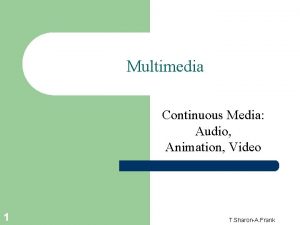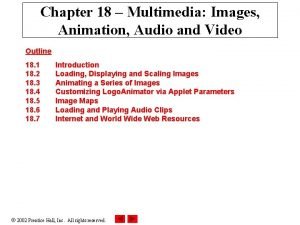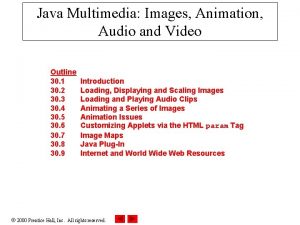Animation for Video Games Wurood Shaher Video games









- Slides: 9

Animation for Video Games Wurood Shaher

Video games have certainly come a long way since the Pong days. Video games are no longer a few pixels on the screen making a basic geometric shape; they're complex pieces of art that take years and years to create. Most video games are rich with story, just like you would see in any movie. • How Animation for Games is Different from Animation for Movies

• We might think animation for video games and animation for movies are really the same thing. • Even though the same tools and principles of animation apply to both mediums, the processes and techniques actually differ greatly between the two. • I will talk about how creating animations for movies and animation for games is different, and what you need to know if you want to pursue a successful career as a game animator.

Animation in Movies. • When it comes to animation for movies, the animator is only responsible for animating whatever is in the view of the shot camera. In other words they only have to worry about one camera angle at a time. If you're watching a movie, you hit the "Play" button on a movie you can't rotate around to look at the whole set. So you're stuck looking at whatever the camera is viewing. • This allows an animator working on a movie to cheat in many ways, because they know that the shot will only be seen from one angle. So if it looks great from that angle, that's ultimately all that matters. • This isn't to say animating for movies is easy. Quite the contrary. But there are certain difficulties that arise with video game animation that can be very different than the difficulties that arise with animating for movies.

• In movies the audience has no control over what's happening. In a sense they're just along for the ride. If you were to get a behind the scenes look at a movie you'd see a whole set, with the director, lights and many other things sitting right behind the camera. As long as they're out of the shot of the camera, the audience is never going to see the whole production crew.

Animation in Games • Games, however, are meant to be interactive. When you play a game, you'll have complete control of the character and the camera. You're the one driving the story forward and making the character move. So not only does the animation need to look good, it needs to look good from every possible angle. • If the game is third person, and the player rotates the camera around they'll see the walk or run cycle from a completely new angle. This new angle can revealing things like knee pops that may not have been visible in the normal camera view. These are things that a game animator needs to take into account to ensure their animation holds up to whatever the player may throw at it.

• The real-time rendering also the reason why most games avoided adding sound other than musical backdrops in repeating MIDI or WAV format; adding voices to characters other than generic "beast" sounds would triple or double the strain on the rendering output engines, and slow the game down even further. Again, this limitation is not evident in movies, where speech and varied sound effects are necessary for the overall effect; but because movies aren't being rendered frame-by-frame as we watch, there's no need to cut corners on the audio. • The timing for animations in games is often determined by the needs of the player inputs. Nothing is more frustrating than getting caught in a gun fight in Call of Duty and suddenly having to reload, typically resulting in your death.

• The timing for animations in games is often determined by the needs of the player inputs. Nothing is more frustrating than getting caught in a gun fight in Call of Duty and suddenly having to reload, typically resulting in your death. • The next difference to keep in mind is the amount of programming that goes into a video game's animation, interactivity, and rendering. Because a movie is meant to be viewed but not interacted with, the programming inherent is only oriented towards producing visible results without any input from a user. • In video games, every action is controlled by the user; motion sequences must be programmed in as a response to individual buttons or combinations of buttons; then as a result objects or beings in the environment have to be programmed to be "sensitive" to the actions of the user-controlled models, to enact their own programmed motion sequences at the appropriate moments.

• References: • https: //www. lifewire. com/animating-for-video-games-vs-movies-141113 • https: //www. pluralsight. com/blog/film-games/how-animation-for-games-is-different-fromanimation-for-movies

















